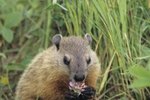
Porcupines and hedgehogs have several external features in common, most notably their covering of "quills" -- modified hairs that have evolved into sharp spines that offer protection against predators. Though they may look similar to each other, hedgehogs and porcupines are not at all related. Instead, they evolved their prickly spines through the process of convergent evolution, which, according to biologist Neil Gostling, has allowed them to solve the same problem (protection, in this case) independently of each other.
Porcupines

Though they may not look like a relative of mice and rats, porcupines are, in fact, classified as rodents. The common name "porcupine" does not refer to a single species of prickly rodent, but rather two different families of species -- Erethizontidae, or New World porcupines and Hystricidae, or Old World porcupines. Depending on the species, porcupines can be fairly small, weighing just over two pounds and reaching a body length of 15 inches, or very large, weighing up to 77 pounds and reaching a body length of 36 inches. According to the University of Michigan Museum of Zoology, there is quite a bit of variation among porcupines in body shape, size and quill distribution.
Hedgehogs

As with porcupines, the common word "hedgehog" refers to more than one species of animal. In this case there are 15 different species of hedgehog, all belonging to the family Erinaceidae, as stated by National Geographic. While porcupines belong the order of animals known as rodents, hedgehogs are members of the insectivore order, along with shrews and moles. Hedgehogs tend to be small -- between four and 12 inches in length and between five and 56 ounces in weight -- and have short, tightly-packed quills.
Geography
Hedgehogs and porcupines can be found across the globe, but rarely overlap one another in geographic range. Porcupines are found across North and South America (New World porcupines), and in southern Europe, Asia and Africa (Old World porcupines). Hedgehogs reside only in the Old World, making their homes in Asia, Africa and throughout Europe. Hedgehogs also have been introduced into New Zealand.
Behavior & Diet
Old and New World porcupines, as well as hedgehogs, are nocturnal, meaning they are most active during the nighttime hours. Hedgehogs are opportunistic carnivores and spend their time digging for any number of small animals, including worms, grubs, insects, frogs, snakes and even mice. Porcupines, on the other hand, are mostly herbivores and consume berries, bark, roots, flowers, seeds, tubers and grasses, though they also will eat the occasional insect or small reptile, according to the San Diego Zoo.




